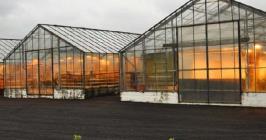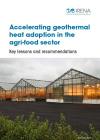

-
-
IRENA (2019), “Accelerating geothermal heat adoption in the agri-food sector”, International Renewable Energy Agency, Abu Dhabi.
Copied
/-/media/Files/IRENA/Agency/Publication/2019/Jan/IRENA_Geothermal_agri-food_2019.pdf
Copied
Accelerating geothermal heat adoption in the agri-food sector: Key lessons and recommendations
Newsletter
Predominantly known for power generation and district heating, geothermal energy can also be used in its primary form (i.e. heat) in the agri-food sector – for instance in greenhouses or for food drying and processing. Using it for such purposes can help increase food availability, reduce dependency on fossil fuels, protect against price volatility and diminish harmful emissions from the sector. Furthermore, it can significantly reduce food waste.
Several geothermal applications in food processing and agriculture require low temperatures and can therefore be deployed in areas where the geothermal resources would not be suitable for power generation. These applications could increase the number of countries and regions that could benefit from such indigenous and renewable energy source. Despite its promising potential and increasing interest from policy makers and key stakeholders, direct use of geothermal heat in food-related applications across the world is still rather limited.
Against this background, this publication aims to increase awareness, share experiences and lessons, and provide recommendations for expanding geothermal heat use in the agri-food sector. The analysis in this document suggests the following six broad critical factors.
- The existence of legislation awarding rights to develop geothermal resources beyond power generation with clear and transparent licensing procedures and, where possible, streamlined for smaller-scale projects.
- The establishment of tailored policy instruments for geothermal heat, notably to share/mitigate the risks associated with the initial and more capital intensive phases of a project.
- The integration of geothermal plans into industrial and rural development strategies and the involvement of local communities and entrepreneurs. These strategies may include measures aiming to attract new productive activities around geothermal areas.
- In new and emerging markets, support provided to feasibility studies and pilot projects to improve the understanding of the geology and assess the heat demand profile of productive activities located near the geothermal resources.
- Capacity building and training of the local workforce in food production and processing (e.g. in dryer use) to ensure efficient operations and catalyse the wider deployment of geothermal in agri-food projects.
- Wise management of geothermal resources to ensure compatibility with the environment and long-term economic sustainability.
Countries aiming to develop geothermal energy applications for food and agriculture may benefit from international platforms such as the Global Geothermal Alliance to share experiences and insights on technical, policy, regulatory and financial solutions and to explore opportunities for co-operation.
This publication has been developed within the framework of the Knowledge Sharing Platform of the Global Geothermal Alliance.




